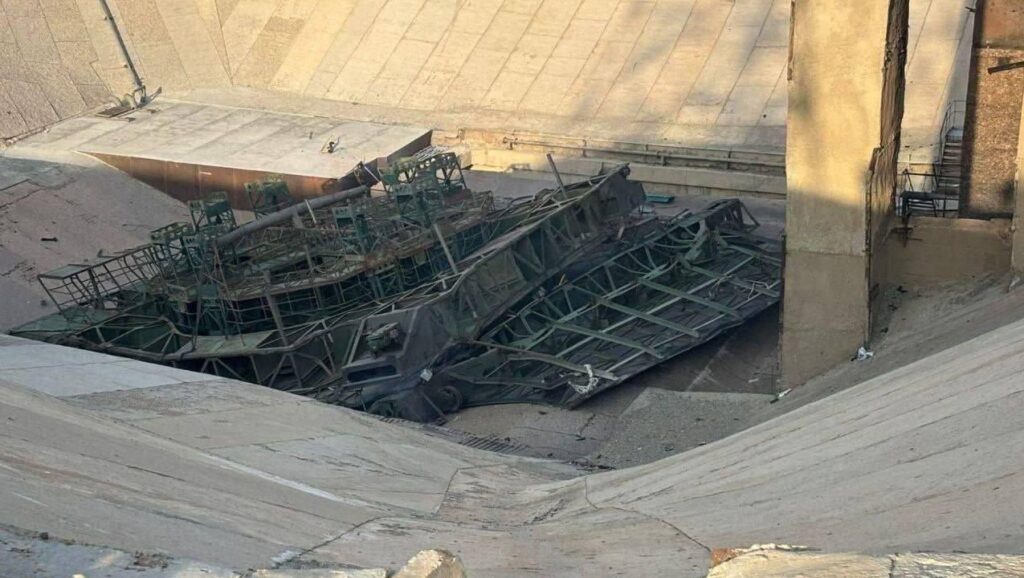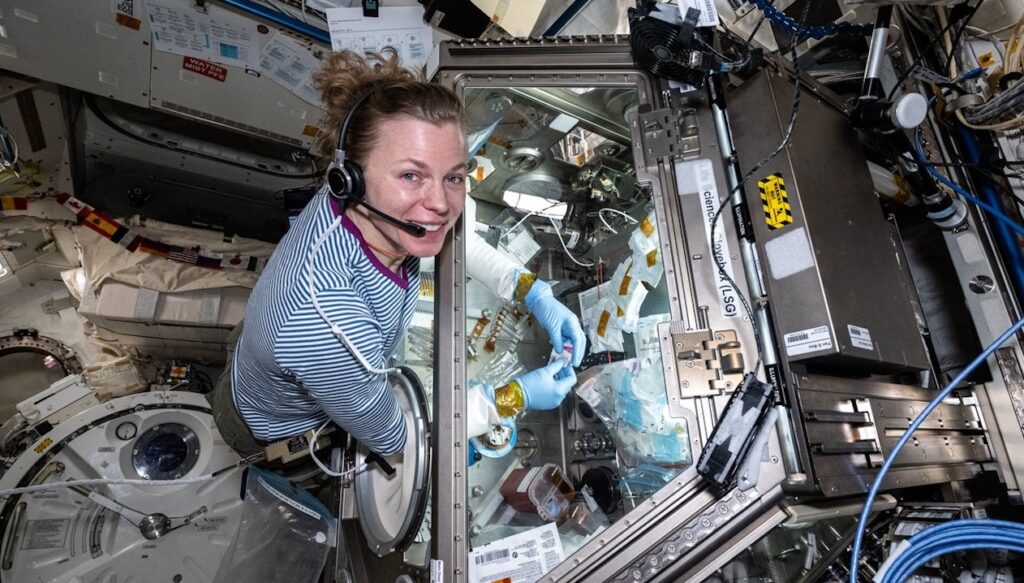Russia Is Using ISS For Overt Propaganda
FYI @Rogozin
“NASA strongly rebukes Russia using the International Space Station for political purposes to support its war against Ukraine." pic.twitter.com/mCJoGQw3xM
— NASA Watch (@NASAWatch) July 7, 2022
 Keith’s note: Cosmonauts Oleg Artemyev, Denis Matveyev, and Sergey Korsakov posed with a flag of the Luhansk People’s Republic on the International Space Station.
Keith’s note: Cosmonauts Oleg Artemyev, Denis Matveyev, and Sergey Korsakov posed with a flag of the Luhansk People’s Republic on the International Space Station.
NASA’s response: “NASA strongly rebukes Russia using the International Space Station for political purposes to support its war against Ukraine, which is fundamentally inconsistent with the station’s primary function among the 15 international participating countries to advance science and develop technology for peaceful purposes.”









Time to schedule the date when we cut loose the Russian segment.
The whole station will need to be de-orbited before much longer. Better to keep it together until then. We really don’t want a derelict Russian half-station flying uncontrolled.
This is not true. The US side of ISS was built modularly,. with replaceability and maintainability the reasons. All the elements were designed so they could be maintained on a long term permanent basis. Thanks to that government/contractor mindset that is NASA, once it was built, the next step in ‘leadership’s’ ‘mind’ was to trash it so that they could get even more money to build something new. Just as NASA has done with every manned project, most recently Shuttle. Whyimprove upon it when we can start over? Its very wasteful and in the case of Orion and SLS weve seen their goal was not spaceflight but expending money, transferring wealth from the taxpayer to big aerospace.
Module lifetime is limited by metal fatigue in the hull. Zarya has already started to crack and the US modules are on the clock as well. That’s why NASA is planning to retire the station in 2030. That’s only eight years away, and there is question that they are being overly optimistic.
Some of the newer modules might be moved to Axiom’s new station, but the older modules will likely be deorbited together. Most of the modules have components likely to survive reentry, so it’s safer to bring it all down at once in an uninhabited area of the Pacific than risk multiple Skylab incidents.
Russian modules were designed for short lifespans. US (ESA and Japan) modules were designed originally for much longer durations. If desired the modules could easily be swapped with new ones if there were serious life issues. All the US modules were launched by Shuttle so none are newer than 10 years.
The Russian modules were designed for 25 years, just like the US modules, and can be replaced just as easily. They just can’t afford it. Even if they could, it is better to make a clean split and walk away.
I don’t know where you get your information; so much of it is totally incorrect and you seem to be deliberately trying to mislead people.
Stresses in orbit are less severe than for example stresses on a large passenger jet. In orbit the main stress is due to temperature expansion and contraction. Stresses on a jet are from pressure variations between the surface of the earth and high altitudes.
All of the Russian Salyut/Mir/ISS modules were designed for a lifespan of 5 years. Zarya and Zvezda sat on the ground for 15-20 years and no one knows for sure how that affected their lifespan. Mir survived for 15 years and so the Russians said that it demonstrated in excess of a 15 year lifespan. Zvezda and Zarya are now about 40 years old and have been in orbit for 24 years. Their design with the multiple different diameters and truncated conical transition sections increases stresses on the structure. Every day those modules stay in orbit establishes new certification limit experience. There are leaks that have appeared. Some were not related to temperature stresses.
The US-side modules are simple cylinders and the interior outfitting mainly floats within the cylinders; these factors reduce stress on the structure. These modules were originally to have been designed to a 20 year certification life but supposedly for contractual purposes and to reduce funding the lifespan was reduced to 10 years although in fact it did not involve any changes in the design. Evaluations are done periodically to show the modules will survive for even longer periods than they have been in orbit. Right now its been calculated they have no trouble making it until 2030 which makes it 25-30 years; there is no reason to believe the US-side modules cannot go for 50 years or even longer.
NASA is acting shizophrenic, indeed. It is necessary to stop any cooperation with russia in whole, not only in space relations. https://novosti-kosmonavtik…
Well NASA was very magnanimous back in 1993 when they brought the Russians into ISS. NASA conferred “ownership” of half of ISS on the Russians. I guess the Russians can do pretty damn near anything they want with their half.
Back in 1993 they were a respected former adversary, they built and launched their own modules, and they bailed out NASA when Shuttle was grounded, so inviting them to the party wasn’t wrong or a mistake. But they’ve burned whatever good will they previously earned and shouldn’t be invited to the next space station party. It’s too bad, really, but this is what Putin has brought them to.
No, in 1993 they were a former adversary. They were down on their luck and needed assistance in the form of foreign aid. Mainly what they could provide were a rescue capsule and a couple of autonomous modules to start off the ISS. Columbia was ten years in the future. Bailing NASA out came even later. We already had several ISS partners. The Russians should have been offered some aid in exchange for what they could provide at the front end. Offering up half the resources, half the crew, half ownership while the other 15 partners shared the other half of the resources. Less than wise.
I didn’t intend to say that Shuttle was grounded in 1993, but that the possibility was part of why Russia was invited to the table: Only the US and Russia had crewed space programs at the time, so if Shuttle had a problem then Soyuz could keep the station operational. That scenario did in fact play out, proving the wisdom of the decision. I apologize for not being clear.
Russia wasn’t offered half of the resources, they provided half. They built and launched nine of the station’s modules, of which the US bought one (Zarya) as part of an aid package. That is second only to the US itself and remains a far bigger contribution than the other 15 partners combined.
That Russia has backslid horribly under Putin and is no longer a good partner doesn’t change the fact that in 1993 they were the only country in the world capable of matching the US in space.
Soyuz was a rescue vehicle that would obviate the need for a US built CEV. It was not anticipated at that point that the Shuttle would have a problem that would incapacitate it. And when the Shuttle eventually did have a problem the US had to pay for use of the Soyuz just as the US had to pay for the first module built by the Russians. The Russians eventually added more modules but mainly for their own purposes. All were old technology built for another program. Europeans and Japanese each provided multiple modules as did the US, which also provided most of the electrical and other support systems. Russians mainly just provide resources for their own modules and crew. Early in the program the Russians saved the US from having to built a control and propulsion module, but after the first few couple years the Russian contribution was not as significant.
That was indeed a consideration due to the Shuttle’s endurance limits.
They already had precedent for the Shuttle being temporarily grounded after Challenger.
Availability as a backup doesn’t mean the backup service won’t incur usage fees. Buying Zarya was part of an aid package, but it was also enticement to get the Russians to join ISS instead of building their own new station (Mir 2) after Mir 1 was decommissioned.
The US modules are mainly for US purposes, and the ESA and JAXA modules are for their own purposes.
Zarya was originally built for Mir 1 and Zvezda was built for Mir 2. At the time Russia was the world leader in space station design. It was “old technology” by modern standards, but so were the US modules.
The US built nine modules. The Europeans built two (Columbus and the Cupola) and the Japanese one (Kibō).
Just as the US mainly provides resources for the US half.
Russia’s control and propulsion module is still in use, just as the US power generation modules are still in use. Russia was originally responsible for life support but that is now a distributed system throughout the station.
Several errors.
“The US modules are mainly for US purposes, and the ESA and JAXA modules are for their own purposes.”
No,
the US, ESA and Japan modules are essentially interchangeable with similar design and similar interfaces. Racks and equipment can be moved almost at will from one module to another. By international agreement, the US ‘owns’ half the resources in the ESA and Japan modules and in fact much of the US equipment is in those modules, built by those countries. The Russian module are not interchangeable and hatch size restricts equipment going into the Russian modules..
Zarya was originally built for Mir 1 and Zvezda was built for Mir 2.
No.
Both Zarya and Zvezda were built as part of the Salyut/Mir buildup in the 70s/80s. They could have been used for Mir or Mir II. Neither was completed until used for ISS.
The US built nine modules.
No.
The US built Node 1, the US Lab and the Joint Airlock. Columbus, Cupola, Nodes 2 and 3, MPLM were all built by ESA, some in trade for US services like Shuttle launches. US built and provided systems provide power, cooling, life support and propulsion. US, Japan and the Russians now provide logistics support. At one time ESA provided logistics support until the ATVs were deferred to the Orion program.
In most cases US, ESA, Japan and Canadian services are through barter agreements. In almost every case the Russians demand cash from the others for services they provide like crew launches. In a few instances there have been some recent discussions of even barters between the Russians and others such as putting aa Russian crewman on a US launch in exchange for a US crewman on a Russian launch.